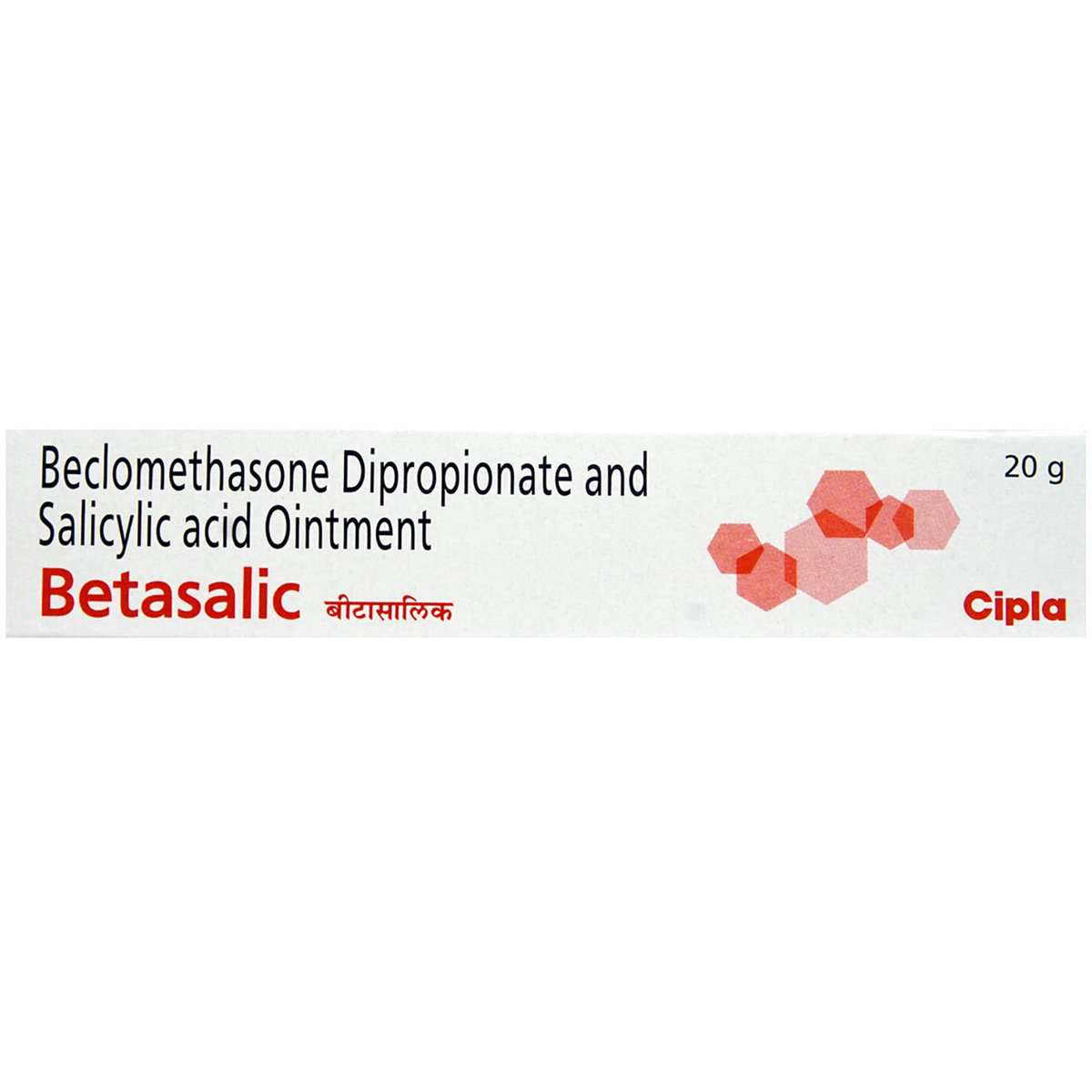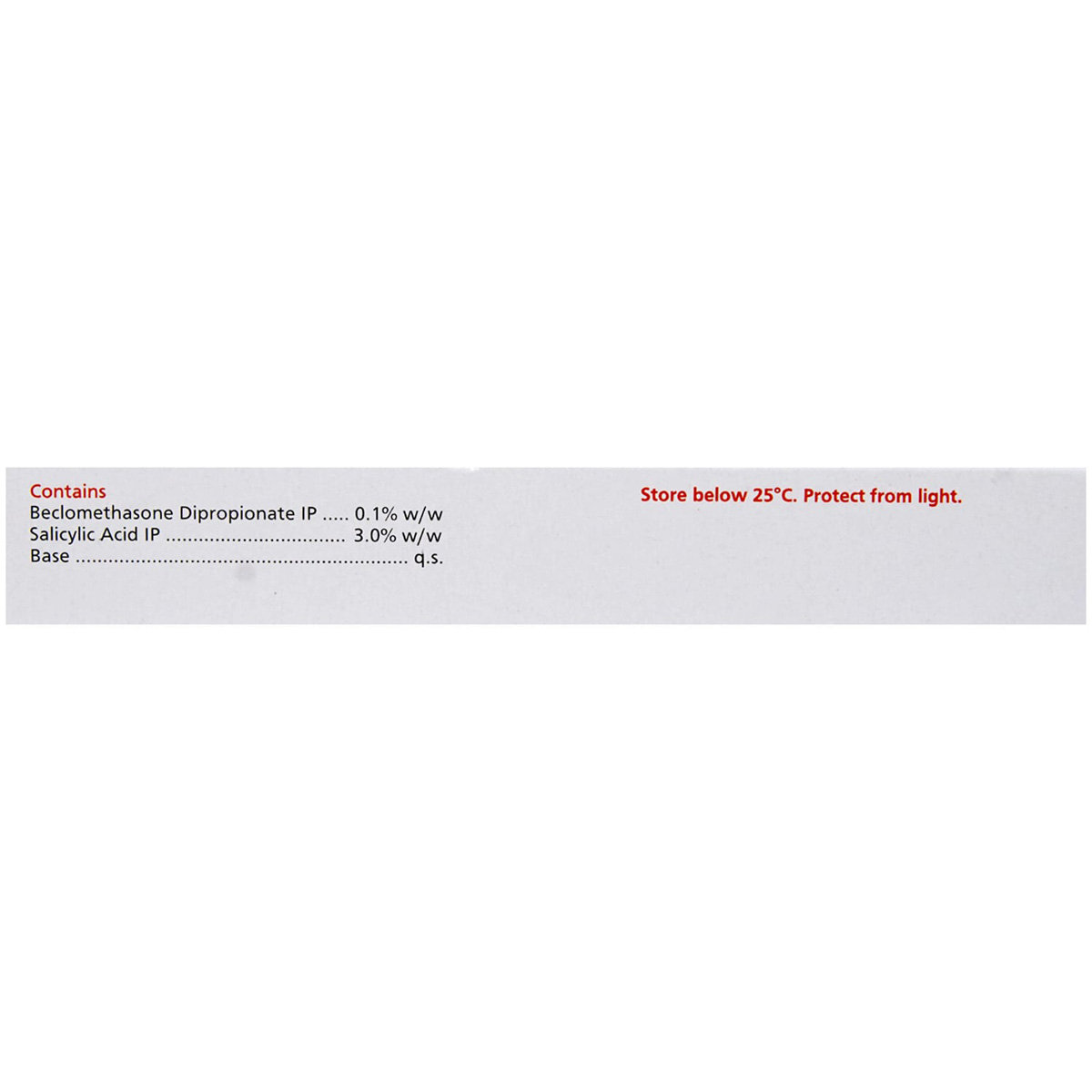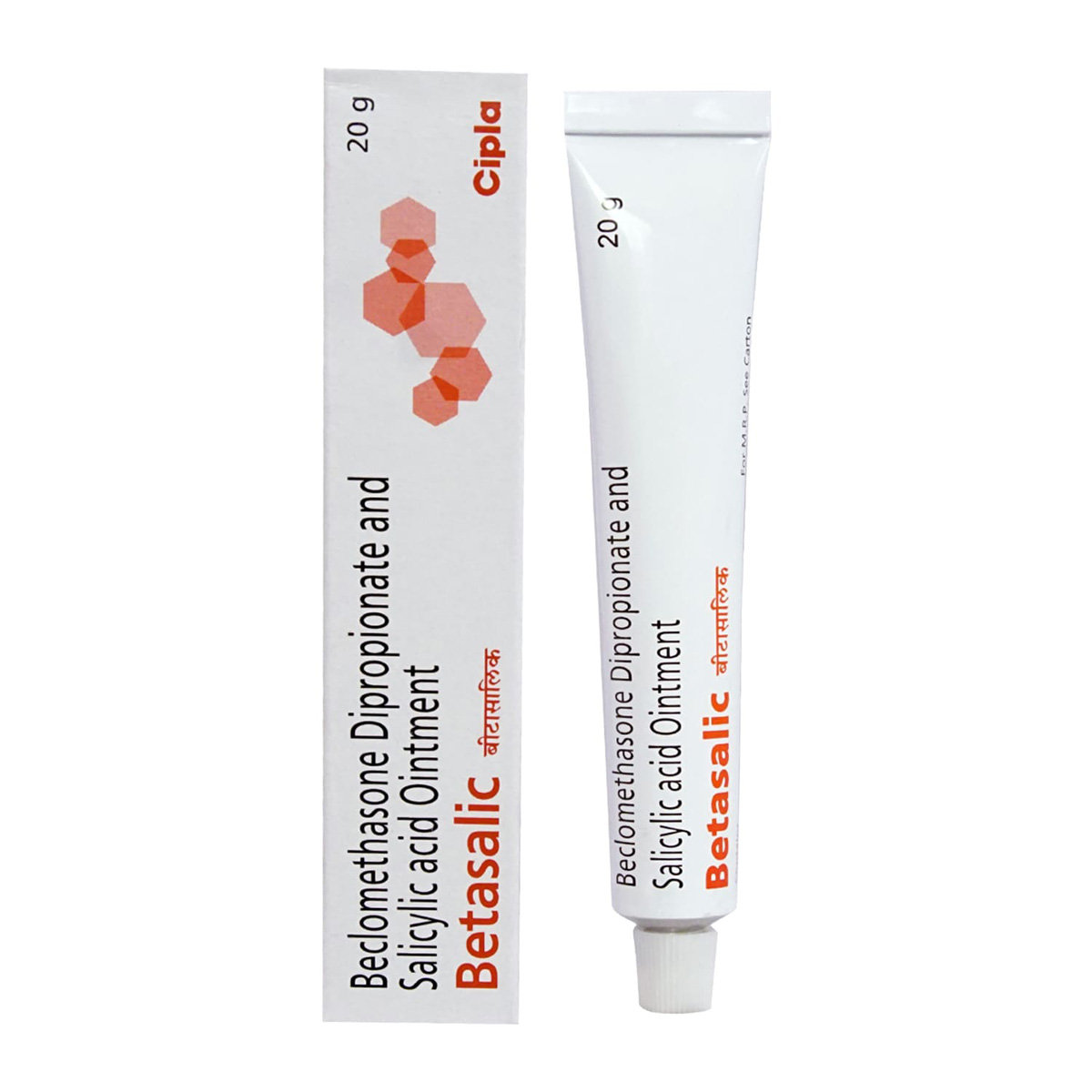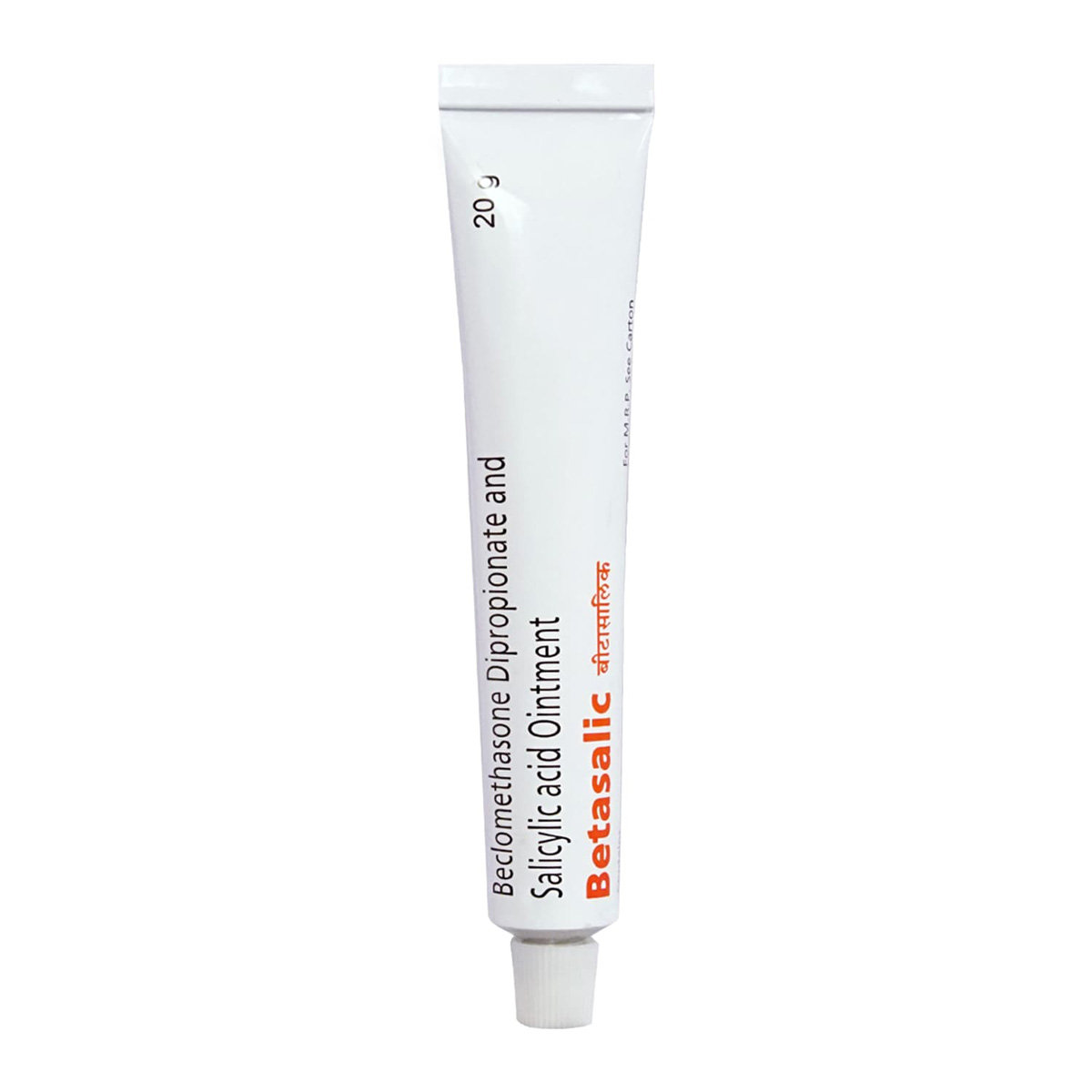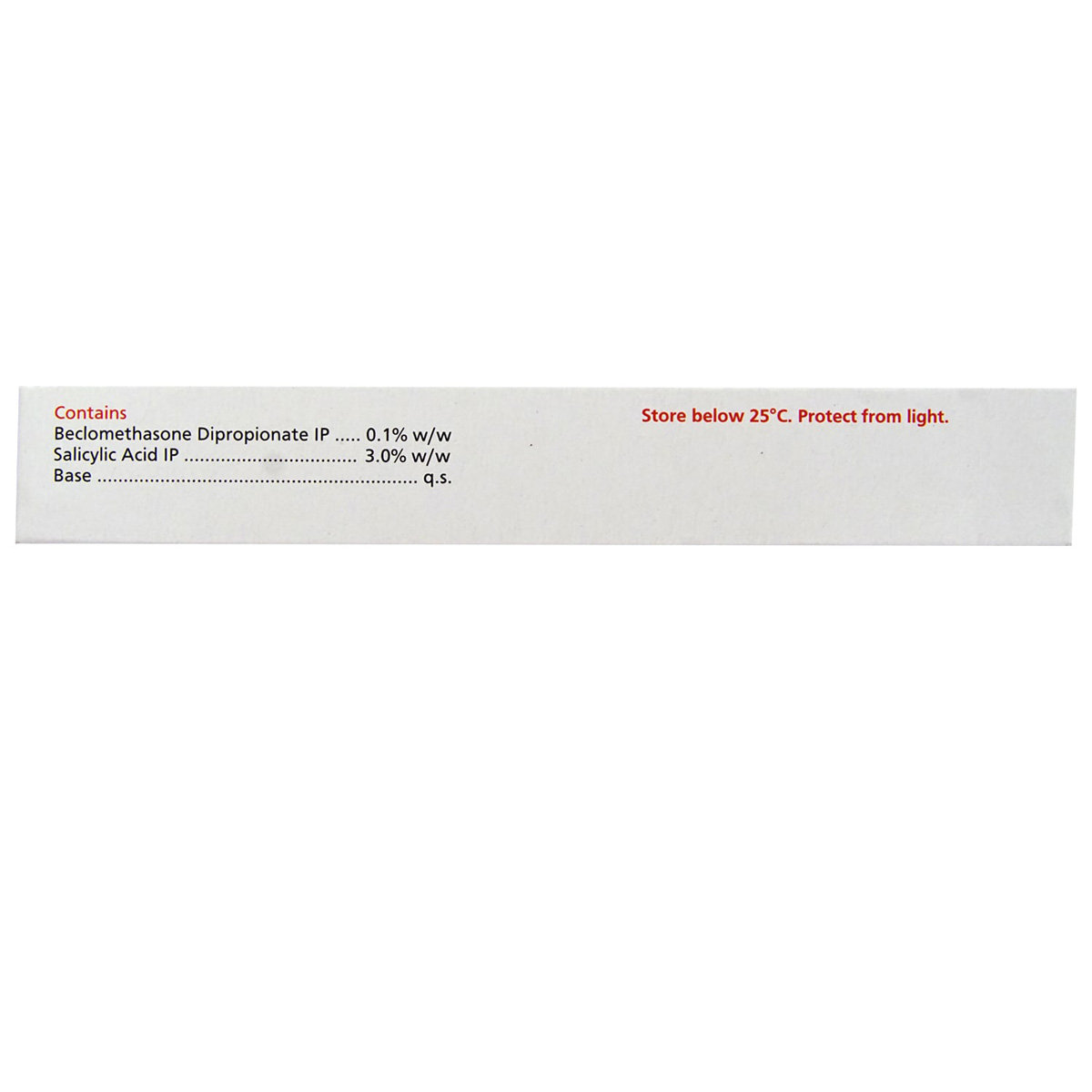Betasalic Ointment 20 gm
MRP ₹109
(Inclusive of all Taxes)
₹16.4 Cashback (15%)
Provide Delivery Location
Online payment accepted
 Prescription drug
Prescription drugWhats That
Composition :
Manufacturer/Marketer :
Consume Type :
Expires on or after :
Return Policy :
About Betasalic Ointment
Betasalic Ointment is a dermatological medication that used to reduce swelling, itching redness and dead skin cells caused due to specific skin problems such as psoriasis (scales and itchy, dry patches) and eczema (itchy, cracked, swollen or rough skin). The swelling of the skin occurs when an allergic reaction or skin irritation releases several substances in the skin that widens blood vessels and cause itching, redness, pain and swelling in the irritated area.
Betasalic Ointment contains Beclometasone (steroids) and Salicylic acid (anti-inflammatory/keratolytic) that works together by reducing the amount of inflammatory chemicals your body makes thereby stopping the body’s natural immune response, which helps to control swelling and inflammation. When the skin reacts to any allergens, such chemicals are released typically. Salicylic acid belongs to the class of keratolytic agents that works by breaking down a protein known as keratin (that forms part of skin structure) and removes dead skin cells and softens skin. Also, it enhances beclometasone absorption into the skin.
Betasalic Ointment is only for external use. In case Betasalic Ointment comes in contact with these areas accidentally, rinse with water thoroughly. Some people may experience side effects like skin rash, inflammation (swelling and redness) of hair follicles, blistering, itching, swelling, stinging or burning sensation at the site of application. Most of these side effects of Betasalic Ointment do not require medical attention and gradually resolve over time. However, if the side effects persist and/or worsen, please consult your doctor.
If you are known to be allergic to Betasalic Ointment or any other medicines, please tell your doctor. If you are pregnant, planning for pregnancy or a nursing mother, it is advised to consult a doctor before using Betasalic Ointment. Do not use Betasalic Ointment in more than prescribed doses, on large areas of the body or for a prolonged time as it may change the levels of some hormones in the body. Do not wrap or cover the treated area with plasters or bandages. Avoid smoking or going near naked flames as the fabric (bedding, clothing, dressings) that is in contact with Betasalic Ointment catches fire and burns quickly.
Uses of Betasalic Ointment
Directions for Use
Key Benefits
Betasalic Ointment is a combination of two drugs, namely; Beclometasone and Salicylic acid. Betasalic Ointment is used to reduce swelling, itching redness and dead skin cells caused due to certain skin problems such as psoriasis (scales and itchy, dry patches) and eczema (itchy, cracked, swollen or rough skin). Beclometasone is a corticosteroid that works by acting inside skin cells and inhibits the release of certain chemical messengers in the body that cause redness, itching and swelling. When the skin reacts to any allergens, such chemicals are released normally. Salicylic acid is a keratolytic agent that works by breaking down a protein known as keratin (a component of skin structure) and removes dead skin cells and softens skin. Also, it enhances beclometasone absorption into the skin.
Storage
Drug Warnings
If you are known to be allergic to Betasalic Ointment or any other medicines, please tell your doctor. If you are pregnant or a nursing mother, it is advised to consult a doctor before using Betasalic Ointment. Do not use Betasalic Ointment in more than prescribed doses, on large areas of the body or for a prolonged time as it may change the levels of some hormones in the body. Do not wrap or cover the treated area with plasters or bandages. Avoid using Betasalic Ointment for more than 5 days in children and on the face. Avoid smoking or going near naked flames as the fabric (bedding, clothing, dressings) that is in contact with Betasalic Ointment catches fire and burns easily. If you have rosacea (redness and often red, small, pus-filled bumps on the face), psoriasis, acne, dermatitis (redness and swelling of the skin) around the mouth, chickenpox, cold sores, nappy rash, genital itching or other skin problems, glaucoma, cataracts, diabetes, adrenal gland, liver or blood circulation problems, inform your doctor before using Betasalic Ointment. This medicine should not be used in bacterial/fungal infections, or napkin eruptions, without suitable concomitant anti-infective therapy. In rare cases, adrenal hormone suppression may also occur with Betasalic Ointment, especially in infants and children.
Drug-Drug Interactions
Drug-Drug Interactions
Login/Sign Up
Drug-Food Interactions
Drug-Food Interactions
Login/Sign Up
Diet & Lifestyle Advise
- Eat foods rich in quercetin (a flavonoid) such as apples, cherry, broccoli, spinach and blueberries.
- Consuming food rich in probiotics helps in developing the immune system against allergies.
- Limit intake of food that might trigger allergies such as dairy products, soy, eggs, and nuts.
- Avoid consumption of foods with excess sugar as it may flare-up inflammation.
- Include fruits, vegetables, whole grains, healthy fats and fish in your diet.
- Reducing stress and maintaining a regular sleep pattern would be helpful.
- Avoiding getting in contact with harsh soaps, detergents and rough fabrics.
Side Effects of Betasalic Ointment
- Skin rash
- Inflammation (swelling and redness) of hair follicles
- Blistering
- Itching
- Swelling
- Stinging or burning sensation at the site of application
Habit Forming
Therapeutic Class
All Substitutes & Brand Comparisons
Author Details
We provide you with authentic, trustworthy and relevant information
Drug-Diseases Interactions
Drug-Diseases Interactions
Login/Sign Up
FAQs
Betasalic Ointment is a combination of two medicines: Beclometasone and Salicylic acid. Beclometasone is a corticosteroid and reduces symptoms of skin infections such as redness, itching, and swelling. On the other hand, Salicylic acid is a keratolytic agent that works by breaking down a protein known as keratin (a component of skin structure) and removes dead skin cells and softens skin.
You are recommended to use Betasalic Ointment on the face only if advised by your doctor and do not use for more than 5 days on the face as the skin on the face thins easily.
The safety and efficacy of Betasalic Ointment have shown no difference in young and elderly patients. So, Betasalic Ointment can be given to treat skin infections in elderly patients.
No, you are not recommended to stop using Betasalic Ointment without consulting your doctor as discontinuing Betasalic Ointment suddenly may cause redness, burning or stinging sensation of the skin. Therefore, use Betasalic Ointment for as long as your doctor has prescribed it, and if you experience any difficulty while using Betasalic Ointment, please consult your doctor so that the dose may be reduced gradually.
No, you are not recommended to use Betasalic Ointment if you have rosacea (redness and often red, small, pus-filled bumps on the face), acne, dermatitis (redness and swelling of the skin) around the mouth, chickenpox, cold sores, nappy rash, genital itching or other skin problems as it may worsen the condition. However, inform your doctor if you have any of these conditions before using Betasalic Ointment.
Drug-Drug Interactions Checker List
- ISOTRETINOIN
- TRETINOIN
- TRIFAROTENE
- TAZAROTENE
- ADAPALENE
Special Advise
- Do not use bandages or dressing on the treated area.
- Avoid contact of Betasalic Ointment with nose, mouth or eyes. In case Betasalic Ointment comes in contact with these areas accidentally, rinse with water thoroughly.
Disease/Condition Glossary
Skin infection: The swelling of the skin occurs when an allergic reaction or skin irritation releases several substances in the skin that widens blood vessels and cause itching, redness, pain and swelling in the irritated area.
Eczema: Eczema is a skin inflammatory condition characterized by red and itchy rashes. The most common cause of eczema is allergies. Contact with soaps, dyes, chemicals, or other irritants may trigger rashes. Avoiding the triggers helps to prevent flare-ups of eczema.
Psoriasis: Psoriasis is an autoimmune skin disease characterized by red, itchy, and scaly rashes. This condition occurs when skin cells grow and buildup rapidly, resulting in scaly rashes. It is a chronic disease and doesn’t have a permanent cure. So, to avoid flare-ups of the disease, avoid triggers such as stress and cold.

Have a query?
Alcohol
Safe if prescribed
Interaction of Betasalic Ointment with alcohol is unknown. Please consult a doctor before consuming alcohol while using Betasalic Ointment.
Pregnancy
Consult your doctor
Betasalic Ointment is a Category C pregnancy drug and is given to a pregnant woman only if the doctor thinks benefits outweigh risks. So if you are pregnant or planning for pregnancy, please consult a doctor.
Breast Feeding
Consult your doctor
Do not apply Betasalic Ointment on the breast area or nipple before breastfeeding the baby. Betasalic Ointment is given to breastfeeding mothers only if the doctor thinks benefits are greater than risks.
Driving
Safe if prescribed
Betasalic Ointment usually does not affect your ability to drive or operate machinery.
Liver
Consult your doctor
Betasalic Ointment should be used with caution in patients with liver diseases. The dose may have to be adjusted by your doctor.
Kidney
Consult your doctor
Betasalic Ointment should be used with caution in patients with kidney diseases. The dose may have to be adjusted by your doctor.
Children
Safe if prescribed
Please consult your doctor before using Betasalic Ointment in children.

